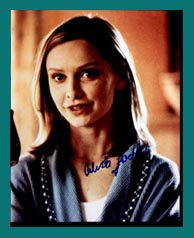What?
Ally McBeal is not a role model for future women litigators?
John Denvir’s commentary on Ally McBeal and Michael
Hayes finds Ally to have much in common with Mary Tyler Moore. In her essay Don’t
Call Me Ally, Lisa Friedman makes a strong case that Ally’s short skirts and
personal trials are no way to win an actual trial. Denvir is right about Ally
having more to do with relationships than the law. Friedman is also correct that David E.
Kelly’s "other" show, The Practice, presents more verisimilitude
about the legal profession.
Ally to have much in common with Mary Tyler Moore. In her essay Don’t
Call Me Ally, Lisa Friedman makes a strong case that Ally’s short skirts and
personal trials are no way to win an actual trial. Denvir is right about Ally
having more to do with relationships than the law. Friedman is also correct that David E.
Kelly’s "other" show, The Practice, presents more verisimilitude
about the legal profession.
However, Ally’s character indeed presents a strong
"professional in progress" role model. Her courtroom tactics may be feeble, but
she struggles to arrive at truths she can believe in. The show’s extensive uses of
music direct our attention to how Ally puts herself on trial. Ally McBeal is more
about personal law, finding a balance between professional and private goals, hearing the
music of inner justice.
Obviously television shows have a long history of using
musical soundtracks, primarily to define the situation, mood, and style of the show. In Perry
Mason, for instance, questioning woodwinds play behind suspenseful scenes, and scenes
end with dramatic brass flourishes. In the show’s theme song, the understated low
brass creeps into a forthright trumpet solo, a sort of musical analog to Perry himself, a
go-ahead, definitive guy. Under this musical conflict beat those menacing piano triplets.
This Cold War-era justice takes itself seriously.
More recent television shows make more complex musical
references for character insights or thematic commentary. Murphy Brown, investigative
reporter on FYI and seeker of justice, is heavy into Motown. Her musical taste
echoes her politics and social values. In Homicide: Life on the Streets, Andre
Braugher’s character Frank is unwilling to participate in his baby daughter’s
baptism. He questions a nun about where to find his lost faith. Back in the squad room,  Death summons him yet again to a dreary
apartment house. There he finds a very old woman, dead of natural causes. Ravel’s Pavane
for a Dead Princess plays on a radio in the background. The music propels Frank to an
epiphany as he recalls the nun’s words about finding the sacred in the everyday. At
that moment, his character receives at least a moment of grace, a partial restoration of
faith.
Death summons him yet again to a dreary
apartment house. There he finds a very old woman, dead of natural causes. Ravel’s Pavane
for a Dead Princess plays on a radio in the background. The music propels Frank to an
epiphany as he recalls the nun’s words about finding the sacred in the everyday. At
that moment, his character receives at least a moment of grace, a partial restoration of
faith.
From the extensive uses of music in Ally McBeal, it
seems that David E. Kelley has learned from these techniques and more. Most of the songs
we hear on the show fall into the Classic Oldies category. As Lawrence Kasdan’s The
Big Chill showed, recycled hits from the sixties and seventies have a strong appeal
with baby boomers.
Ally McBeal uses music on many levels to convey
truths about living and working in law. The loudest example often comes last on the show.
After working all day as members of the Bar, lawyers from Cage and Fish practice lifting
elbows at another kind of bar. Here, dancing and singing provide a harmony to resolve
office conflicts. The law office is upstairs, while the bar is in the same building on the
ground floor. This set-up presents the metaphor of the well-rounded lawyer, exercising
upstairs logic on cases, and accessing a more visceral "lower level" to defuse
daily tensions.
The excellent singer Vonda Shepard appears nearly every
week as a bar regular to provide a free-wheeling, party atmosphere. Her piano is a
versatile magic barrel with upbeat rock, soul, and blues on tap. Shepard even has her own
best-selling CD featuring songs from the show, with a new release just out called By
7:30. In a few episodes, the big-voiced Jennifer Holliday joins the cast as the Cage
and Fish group attends a church with a mostly African-American congregation. This
situation is similar to when Murphy Brown, the quintessential WASP, tries to "get
down" singing Natural Woman with Aretha Franklin. Whereas Aretha ends up
telling Murphy not to sing so loudly, the Ally McBeal characters let loose along
with the rest of the congregation. The episodes of singing and dancing in the church are
similar to those in the bar. Both places are "big tents" of democracy,
cathedrals of expansive acceptance.
Office grind evolves into bump and grind at the bar. The
women employed at Cage and Fish all rock together for girlfriend bonding and to rise above
petty squabbles. With their graceful spins, Fish and Ling display a less idiosyncratic
courting ritual than finger licking, hair spreading, or knee pit massage. Georgia and
Billy dance close and make up from their argument du jour. The anal retentive John
Cage can forget "taking a moment" and discover why he is "drawn" to
Nell. On a recent show (aired April 19, 1999), Nell presents The Biscuit with a birthday
surprise at the bar, a live appearance by John’s musical idol Barry White.
Office pratfalls show clumsy surface embarrassments, but
dancing is the way to get in synch psychologically. Ensemble dancing provides a metaphor
for the blend of individualism and teamwork required of members in a large practice. In
the unisex bathroom, John Cage often bolsters his self- confidence by solo dancing to an
inner Barry White rendition. In one episode, Richard Fish walks in on John. Instead of
reacting with the expected ridicule, Fish joins his law partner in dance. Then Elaine sees
the two and falls into step with perfectly choreographed kicks and turns.
We are not surprised at Elaine’s participation. She
haunts the bathroom, waiting for juicy gossip and sensuous dance moves. Several episodes have
featured a talent show at the bar with all the people from the firm showcasing their
talents. Elaine generally coordinates this effort so she can star. "This show is all
about me," she says.
bathroom, waiting for juicy gossip and sensuous dance moves. Several episodes have
featured a talent show at the bar with all the people from the firm showcasing their
talents. Elaine generally coordinates this effort so she can star. "This show is all
about me," she says.
But we are surprised when Ling arrives and adds her
high-booted leg to the chorus line. She will practice law with them, so the group also
makes room for her in the dance. It is noteworthy that Ally has never been a member of
this musical collaboration. More on that later.
Music expresses each character’s ideal for developing
a workable personal style. In an episode aired the first season, John Cage tells Fish to
listen for the bells. When those golden bells ring, the character is ready, prepared to
fight in court with the best defense for the client. For Fish, the bells clunk together
more often than they ring. This clunk has happened so many times, the sound effect has an
additional connotation, less golden bells than brass balls. This motif fits Fish perfectly
as he blatantly asserts his masculine power in a way that is never separated from sexual
or monetary gains. In one episode (aired April 5, 1999), Fish says that getting fees from
both sides is "music to my ears."
The Biscuit used the bells to supplement his smile
therapy. What began as a parody of self-esteem exercises has evolved into a more poignant
search for understanding. Tracey Ullman has put in a few star turns as Ally’s wacky
therapist recommending that each person have a "song" to boost the ego. How can
we forget Tracey’s own bubbly dancing to her song entitled, of course, Tracy?
Tracey’s flamboyant style contrasts starkly with Ally’s feeble attempts to find
inner music.
Eventually, Ally conjures up I Know Something About
Love, but it plays in her head only at half-tempo. Later in the series, we see the
song work its magic, and not just on Ally. Ally stands on a street corner in downtown
Boston waiting for the crossing light. She thinks of her song and falls into the
energizing beat. Her shoulders shrug, her knees bounce, and before long, all the folks
waiting with her bebop to their inner songs. By the time the light changes, the sea of
humanity crosses the street in a scene reminiscent of the Monty Python sketch featuring
the Ministry of Silly Walks.
To be sure, the scene is comic, but in context, it might
be viewed as a metaphor for all of The Law. What starts out as an individual aberration,
if believed with enough fervency, has the power to change others. If enough join in, the
right aberration becomes mainstream.
For Ally, hearing a smooth music track in a group of
strangers is one thing, but to hear it in the office is quite another. I do not recall any
scene in which Ally joins her colleagues in a dance number. She dances, but with the
blow-up doll or alone in her apartment.
At one point, her solo dance is frantic, almost spastic.
She is Nora in Ibsen’s play A Doll’s House. Then Ally’s roommate
Renee walks in, and the needle shrieks across the track. The "scratching needle"
sound effect breaks into her psyche to tell her that her dream music and reality are too
far apart. Ally’s budding confidence is quashed.
Ally’s roommate Renee already possesses a powerful
inner song. As a present for Ally, Renee sings a duet with Ally’s doctor boyfriend
Greg Butters at the bar. In their luminous, untroubled faces, we see that Renee and Greg
are happy inside the music. They are a better-matched couple than Ally and Greg, or Ally
and Billy, who have never sung together. The camera pans to Ally’s abandoned place at
the table.
Poor Ally! Whenever she starts on a musical flight of
fancy, the needle inevitably scratches across her inner LP. She achieves some
transcendence dancing on a wintry street in her sheep-print pajamas. She cannot feel the
snow dance in her waking life. She tells Tracey the song therapist that she has day dreams
in the office. She cannot wake up. Her inner voice is all wrong for the world out there.
The scratchy needle interrupts, and she startles with her trademark big eyes and shocked
gasp.
In the courtroom scenes of Ally McBeal, justice is
not always served. As in reality, money talks, the guilty may walk, and law practitioners
are fallible. However, to minimize these imperfections, David Kelley uses music to bring a
degree of resolution to each show. Music carries its own internal scale of justice.
Harmony, consonance, and the tonic key, or the musical "home," all push a melody
to its resolution. The familiar melodies of these classic hits capture the vitality and
assertiveness of the human spirit.
Ally shouldn’t worry. Her inner music is already
there. She just needs to listen. The melody most true to her heart is the Ally McBeal
theme song that introduces every episode: Now I’m ready to sing, I been
searchin’ my soul tonight, I see there’s so much more tonight, Now I know I can
shine the light, To find the way back ho--ooo--ome."